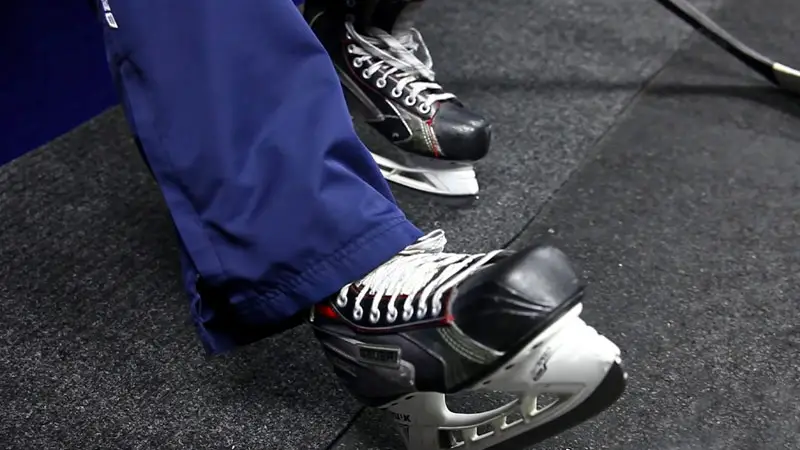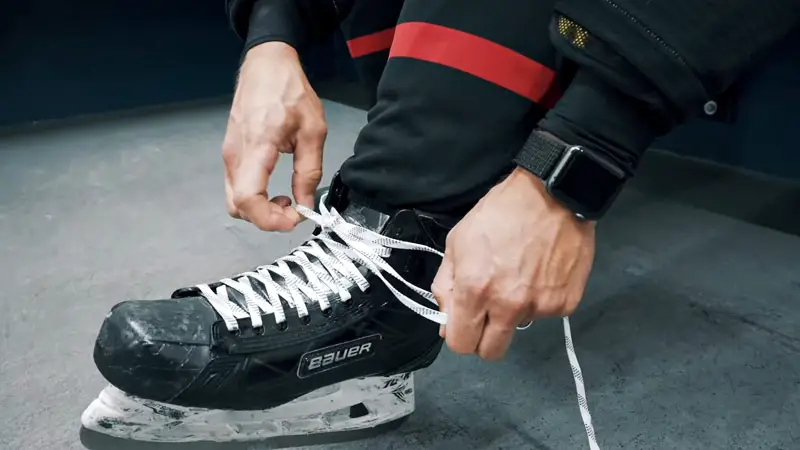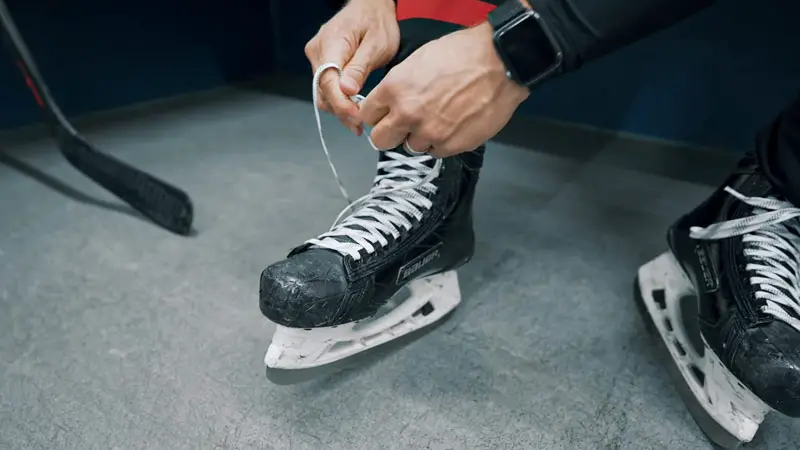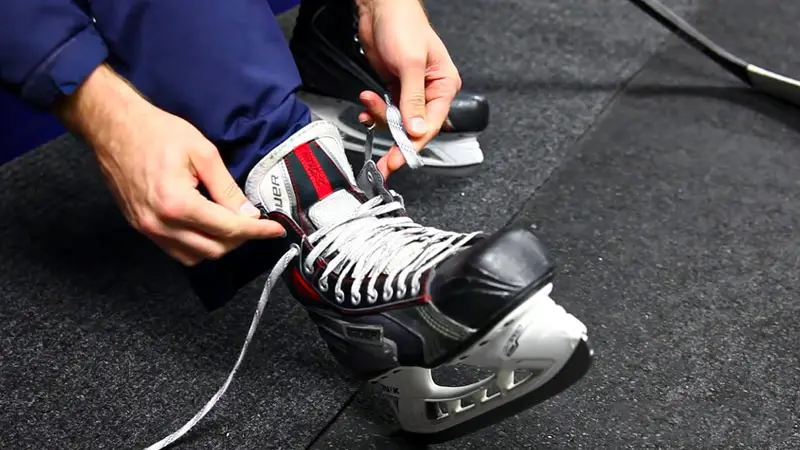Lacing hockey skates is an art, an essential skill that can significantly impact a player’s performance on the ice.
Achieving the perfect balance between support and comfort is crucial, and the lacing technique plays a pivotal role. In this comprehensive guide, we delve into the intricacies of the best way to lace hockey skates.
From traditional criss-cross patterns to innovative locking loops, we explore techniques that cater to various foot shapes and playing styles.
Discover how to enhance ankle stability, control pressure points, and optimize energy transfer for an unparalleled skating experience.
Whether you’re a seasoned player or a beginner, understanding these lacing methods can elevate your game and keep you comfortable during every stride. So, stay sharp.
Importance of Properly Laced Skates
Properly lacing hockey skates is essential for several reasons that directly impact a player’s performance and safety on the ice.
Firstly, a secure and tailored lacing technique provides the necessary ankle support, minimizing the risk of sprains or injuries during quick movements and sudden stops.
Additionally, a well-laced skate ensures a snug fit around the foot, preventing unnecessary friction or pressure points that can lead to discomfort or blisters.
The proper distribution of pressure across the foot enhances overall stability and control, enabling precise maneuvers and powerful strides.
Moreover, a securely laced skate optimizes energy transfer, allowing players to maximize their skating efficiency.
The importance of properly laced skates extends beyond mere comfort, it is integral to a player’s ability to perform at their best, reducing the likelihood of injuries and contributing to an enjoyable and successful experience on the ice.
Best Way to Lace Hockey Skates: Step-by-Step Instruction
Lacing hockey skates properly is crucial for both comfort and performance on the ice. A well-laced skate provides the necessary support, stability, and responsiveness that every hockey player needs.
In this guide, we will explore the best way to lace hockey skates through step-by-step instructions.
Start with a Secure Base
Begin by ensuring that your foot is properly seated in the skate, and the tongue is centered.
Pull the laces tight at the bottom eyelets, creating a snug fit around the forefoot. This initial tightness establishes a secure base, preventing unnecessary movement inside the skate during play.
Utilize the Locking Technique for Ankle Support
As you move up the skate, use the locking technique for added ankle support.
Cross the laces over each other, feeding them through the next set of eyelets. Instead of pulling straight up, angle the laces outward and then pull tight.
This creates a “lock” that stabilizes the ankle joint, reducing the risk of injuries and ensuring optimal power transfer in every stride.
Wrap Around the Back for a Heel Lock
To enhance the heel lock, wrap the laces around the back of the skate before moving to the higher eyelets.
This additional loop helps anchor the heel firmly in place, preventing it from lifting during quick movements. A secure heel lock is essential for efficient energy transfer and control on the ice.
Control Tightness with the Over-Under Technique
To control the tightness across the top of the foot, use the over-under technique. As you move up the skate, alternate the direction in which you thread the laces through the eyelets.
This creates a balanced and evenly distributed pressure, reducing the chances of discomfort or pressure points. Experiment with the tightness at each eyelet to find the perfect balance between comfort and support.
Finish with a Firm Knot
Complete the lacing process by tying a firm and secure knot at the top. This ensures that the laces stay in place throughout the game.
You can experiment with different knot styles, such as a double knot or a surgeon’s knot, to find the one that best suits your preference.
A well-tied knot maintains the desired tension and prevents any loosening during play.
By following these step-by-step instructions, you can achieve a customized and secure fit for your hockey skates, optimizing your performance on the ice while ensuring comfort and injury prevention.
Traditional Hockey Skates Lacing Techniques

Lacing hockey skates using traditional techniques is an art that combines functionality and player preference.
Understanding these methods can greatly impact comfort, performance, and injury prevention on the ice. Here are some traditional lacing techniques used in hockey:
Standard Criss-Cross Lacing
The most common method involves a criss-cross pattern, weaving the laces diagonally through the eyelets.
This technique offers a balanced blend of support and flexibility, catering to players who prefer a classic feel. It’s a versatile option suitable for various foot shapes and playing styles.
Tight Heel Lock Technique
This technique involves focusing on the lower eyelets, creating a tight fit around the forefoot and heel.
This emphasizes heel lock, reducing movement within the skate for enhanced stability. It’s favored by players who prioritize a secure feel, especially during quick lateral movements.
Butterfly Lacing for Wider Feet
Ideal for players with wider feet, the butterfly lacing technique involves skipping eyelets in the middle section, creating a wider opening.
This accommodates the natural width of the foot, reducing pressure points and improving overall comfort for those with broader feet.
Power Lacing for Increased Forward Flexion
For players who desire greater forward flexion, the power lacing technique is employed.
By skipping eyelets near the ankle, this method allows for increased forward lean, beneficial for players who want more aggressive strides and sharper turns.
It provides a customized feel, catering to individual preferences for playing style.
Understanding and experimenting with these traditional lacing techniques can help hockey players find the optimal balance of comfort, support, and performance based on their unique foot shape and playing preferences.
Alternative Hockey Skates Lacing Techniques

While traditional lacing techniques provide a solid foundation, alternative methods can offer players more customization options to enhance comfort and performance on the ice.
Explore these innovative approaches to lacing hockey skates:
Locking Loop Lacing for Precision
This technique involves creating small loops at specific eyelets, allowing players to fine-tune the tightness at different sections of the skate.
Locking loop lacing provides precise control over pressure points, ensuring a customized fit that maximizes comfort and minimizes foot movement within the skate.
Double Helix Lacing for Stability
Double helix lacing adds an extra layer of stability by incorporating a second set of laces that run parallel to the main lacing.
This creates a criss-cross pattern within a criss-cross pattern, offering increased support and reducing lateral movement. It’s particularly beneficial for players seeking enhanced stability during quick directional changes.
Reverse Lacing for Reduced Pressure
Reverse lacing involves starting the lace pattern from the top of the skate and pulling down to the bottom.
This alternative approach can alleviate pressure on the top of the foot, making it an excellent choice for players who experience discomfort in that area.
It also allows for easy adjustment of tightness in the lower sections of the skate.
Gap Lacing for Enhanced Flexibility
Ideal for players who prioritize forward flexion and agility, gap lacing involves leaving small spaces between eyelets in the middle section of the skate.
This promotes increased flexibility around the ankle, facilitating a more natural range of motion for players who want to maximize their agility and responsiveness on the ice.
Exploring alternative lacing techniques empowers hockey players to customize their skate fit, addressing specific comfort or performance preferences.
Tips for Maintaining Properly Laced Skates

Properly laced skates are not only crucial for optimal performance on the ice but also require regular maintenance to ensure longevity and sustained comfort.
Here are essential tips for maintaining your laced hockey skates:
Regular Inspection and Adjustments
Periodically inspect your skate lacing for signs of wear and tear. Check for frayed laces, damaged eyelets, or uneven tension.
Make necessary adjustments to maintain a consistent and secure fit. This proactive approach prevents potential issues during play and ensures your skates provide the necessary support.
Dry Thoroughly After Use
Moisture is the enemy of skate longevity. After each use, remove the insoles and allow both the skates and insoles to air dry.
Avoid leaving skates in a closed bag or damp environment, as this can lead to bacterial growth, unpleasant odors, and deterioration of materials.
Rotate Lacing Patterns
To prevent excessive wear on specific areas, consider rotating your lacing patterns.
Switch between traditional, locking loop, or other lacing techniques to distribute pressure evenly across different parts of the skate. This helps maintain the integrity of the laces and ensures consistent support.
Replace Laces as Needed
Laces bear the brunt of the forces during play and can wear out over time.
Replace laces whenever you notice significant fraying or weakness. Upgrading to high-quality, durable laces can extend their lifespan and provide better overall performance.
Store Properly Between Uses
Store your skates in a cool, dry place between uses. Avoid extreme temperatures, such as leaving them in a hot car or near a heater, as this can affect the materials and adhesives.
Using a skate-specific bag or maintaining a dedicated space for storage helps protect your skates from external factors that could compromise their structure.
By incorporating these maintenance tips into your routine, you not only preserve the integrity of your laced hockey skates but also contribute to a more comfortable and enjoyable experience on the ice.
FAQs
How tight should I lace my hockey skates?
Find a balance; the lower section for a snug fit, then progressively looser towards the top.
Ensure ankle stability with a secure lock but allow flexibility for comfort. Personal preference plays a role, so adjust until you achieve optimal support and comfort.
Should I use a specific knot for lacing hockey skates?
Yes, opt for a secure knot to prevent loosening during play. Double knots or surgeon’s knots work well. Experiment to find the knot style that best maintains the desired tension throughout the game.
How do I address foot pain with laced skates?
Check your lacing technique. Try the over-under method for even pressure distribution.
Ensure proper skate sizing, and consider gel inserts or custom insoles for added comfort. If problems persist, consult with a professional for personalized solutions.
Can I use alternative lacing techniques with my hockey skates?
Absolutely. Traditional and alternative methods offer customization. Experiment with techniques like locking loops or double helix lacing to find what suits your foot shape and playing style.
The key is achieving a balance between support and comfort.
How often should I re-lace my hockey skates?
Regularly inspect your laces for wear and tear. Replace them when frayed or weakened.
A proactive approach ensures consistent support and prevents unexpected issues during play. High-quality, durable laces may extend the time between replacements.
Wrapping Up
In the world of hockey, where precision and comfort are paramount, mastering the art of lacing your skates is a game-changer.
From the foundational criss-cross pattern to advanced locking loops, each technique contributes to a personalized fit that enhances your agility and stability on the ice.
Your skating experience is not just about the game; it’s about the confidence and comfort your skates provide.
As you experiment with different lacing methods, you’ll uncover the ideal combination for your unique playing style and foot anatomy.
Embrace the journey of finding the best way to lace your hockey skates, and watch as it transforms not only the way you play but also how you enjoy the exhilarating sport of hockey. Thank you so much.








James Felix